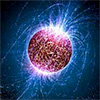 New research reveals the probable existence of a strange quark matter core in massive neutron stars. The study sheds new light on the equation of state of dense matter, bridging the gap between hadronic and quark matter states.
New research reveals the probable existence of a strange quark matter core in massive neutron stars. The study sheds new light on the equation of state of dense matter, bridging the gap between hadronic and quark matter states.
May 18th, 2023
Read more
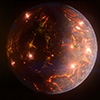 Astronomersl have discovered an Earth-sized exoplanet around a nearby small red dwarf star that appears to be carpeted with volcanoes.
Astronomersl have discovered an Earth-sized exoplanet around a nearby small red dwarf star that appears to be carpeted with volcanoes.
May 17th, 2023
Read more
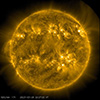 A new study simulated dozens of solar flares and showed that analysis of the Lyman Continuum spectrum formed by hydrogen ionization and recombination can be used for diagnosis of the solar plasma.
A new study simulated dozens of solar flares and showed that analysis of the Lyman Continuum spectrum formed by hydrogen ionization and recombination can be used for diagnosis of the solar plasma.
May 16th, 2023
Read more
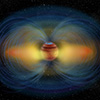 High-resolution imaging of radio emissions from an ultracool dwarf show a double-lobed structure like the radiation belts of Jupiter.
High-resolution imaging of radio emissions from an ultracool dwarf show a double-lobed structure like the radiation belts of Jupiter.
May 15th, 2023
Read more
 Using Webb's NIRSpec (Near-Infrared Spectrograph) instrument, astronomers have confirmed gas - specifically water vapor - around a comet in the main asteroid belt for the first time, indicating that water ice from the primordial solar system can be preserved in that region.
Using Webb's NIRSpec (Near-Infrared Spectrograph) instrument, astronomers have confirmed gas - specifically water vapor - around a comet in the main asteroid belt for the first time, indicating that water ice from the primordial solar system can be preserved in that region.
May 15th, 2023
Read more
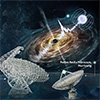 Learn about FRB 20190520B, the first continuously active repeating FRB, and its significant implications for the fields of astronomy and physics.
Learn about FRB 20190520B, the first continuously active repeating FRB, and its significant implications for the fields of astronomy and physics.
May 12th, 2023
Read more
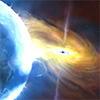 The explosion is more than ten times brighter than any known supernova and three times brighter than the brightest tidal disruption event, where a star falls into a supermassive black hole.
The explosion is more than ten times brighter than any known supernova and three times brighter than the brightest tidal disruption event, where a star falls into a supermassive black hole.
May 12th, 2023
Read more
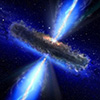 Astronomers have found that supermassive black holes obscured by dust are more likely to grow and release tremendous amounts of energy when they are inside galaxies that are expected to collide with a neighbouring galaxy.
Astronomers have found that supermassive black holes obscured by dust are more likely to grow and release tremendous amounts of energy when they are inside galaxies that are expected to collide with a neighbouring galaxy.
May 11th, 2023
Read more
 Researchers have discovered a new generic production mechanism of gravitational waves generated by a phenomenon known as oscillons, which can originate in many cosmological theories from the fragmentation into solitonic 'lumps' of the inflaton field that drove the early Universe's rapid expansion.
Researchers have discovered a new generic production mechanism of gravitational waves generated by a phenomenon known as oscillons, which can originate in many cosmological theories from the fragmentation into solitonic 'lumps' of the inflaton field that drove the early Universe's rapid expansion.
May 11th, 2023
Read more
 Astronomers have revealed new evidence about the properties of the giant bubbles of high-energy gas that extend far above and below the Milky Way galaxy's center.
Astronomers have revealed new evidence about the properties of the giant bubbles of high-energy gas that extend far above and below the Milky Way galaxy's center.
May 9th, 2023
Read more
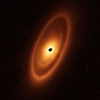 Astronomers imaged the warm dust around a nearby young star, Fomalhaut, in order to study the first asteroid belt ever seen outside of our solar system in infrared light. But to their surprise, the dusty structures are much more complex than the asteroid and Kuiper dust belts of our solar system.
Astronomers imaged the warm dust around a nearby young star, Fomalhaut, in order to study the first asteroid belt ever seen outside of our solar system in infrared light. But to their surprise, the dusty structures are much more complex than the asteroid and Kuiper dust belts of our solar system.
May 8th, 2023
Read more
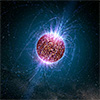 Scientists measured the masses of several key nuclei with high-precision by employing a state-of-the-art storage-ring mass spectrometry technique. Using the new mass data, they investigated X-ray bursts on the surface of a neutron star, thus deepening the understanding of neutron star properties.
Scientists measured the masses of several key nuclei with high-precision by employing a state-of-the-art storage-ring mass spectrometry technique. Using the new mass data, they investigated X-ray bursts on the surface of a neutron star, thus deepening the understanding of neutron star properties.
May 5th, 2023
Read more
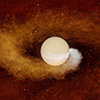 Scientists have observed hints of stars just before, and shortly after, the act of consuming entire planets, but they have never caught one in the act until now.
Scientists have observed hints of stars just before, and shortly after, the act of consuming entire planets, but they have never caught one in the act until now.
May 4th, 2023
Read more
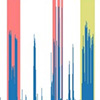 What would the Earth look like to an alien civilization located light years away?
What would the Earth look like to an alien civilization located light years away?
May 3rd, 2023
Read more
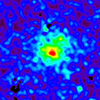 An initial study of dark energy with eROSITA indicates that it is uniformly distributed in space and time.
An initial study of dark energy with eROSITA indicates that it is uniformly distributed in space and time.
May 3rd, 2023
Read more
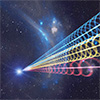 A team of astronomers has discovered 25 new sources of repeating fast radio bursts (FRBs), these explosions in the sky that come from far beyond the Milky Way. This discovery brings the total number of confirmed FRB sources to 50.
A team of astronomers has discovered 25 new sources of repeating fast radio bursts (FRBs), these explosions in the sky that come from far beyond the Milky Way. This discovery brings the total number of confirmed FRB sources to 50.
Apr 29th, 2023
Read more
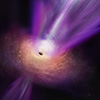 An international team of scientists has used new millimeter-wavelength observations to produce an image that shows, for the first time, both the ring-like accretion structure around a black hole, where matter falls into the black hole, and the black hole's associated powerful relativistic jet.
An international team of scientists has used new millimeter-wavelength observations to produce an image that shows, for the first time, both the ring-like accretion structure around a black hole, where matter falls into the black hole, and the black hole's associated powerful relativistic jet.
Apr 26th, 2023
Read more
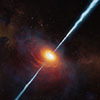 Scientists have unlocked one of the biggest mysteries of quasars - the brightest, most powerful objects in the Universe - by discovering that they are ignited by galaxies colliding.
Scientists have unlocked one of the biggest mysteries of quasars - the brightest, most powerful objects in the Universe - by discovering that they are ignited by galaxies colliding.
Apr 26th, 2023
Read more
 New research reveals the probable existence of a strange quark matter core in massive neutron stars. The study sheds new light on the equation of state of dense matter, bridging the gap between hadronic and quark matter states.
New research reveals the probable existence of a strange quark matter core in massive neutron stars. The study sheds new light on the equation of state of dense matter, bridging the gap between hadronic and quark matter states.
 Subscribe to our Space Exploration News feed
Subscribe to our Space Exploration News feed















